How to wash a blanket?
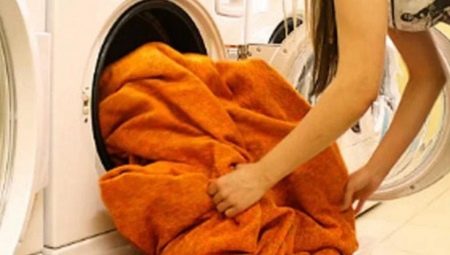
A beautiful and warm blanket is a wonderful attribute of the interior, which allows you to keep warm on cold winter evenings. In addition, a high-quality bedspread will protect the bed from dirt and excess moisture. However, it is quite difficult to care for a blanket; washing the product has its own nuances.
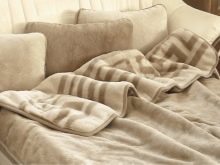


What do you need to consider?
Competent care of a warm blanket is carried out taking into account a number of factors.
- If the bedspread has a long pile, then you need to take care of its safety immediately after purchase.... You can read a lot of useful information on the label.
- Almost every garment has its own label, which indicates the maximum wash temperature, care methods and other important information. Some bedspreads cannot be washed with certain powders or detergents.
- It is best to use a soft brush. Thanks to such a device, the model is quickly put in order and remains clean for a long time. A thick blanket with a long pile needs to be brushed from time to time - so it will look more presentable and brighter. The material will also be softer and more pleasant tactilely.
In case of slight contamination, do not wash the coverlet in the washing machine. Proper care will combine several pre-cleanings. If you cannot remove the stain, or the dirt simply does not come out, you can use a stronger product.



There are methods for dealing with different types of pollution.
- If the fabric just needs to be freshened up a little, to eliminate extraneous odors, then you can hang the product in the fresh air. The wind will carry away all the unpleasant odors, and the blanket itself will look newer.
- When a lot of dust has accumulated in the material, you can try to knock out the blanket like a regular rug. To do this, you need to hang the product on the street and walk over it with a firecracker.
- Small stains are not a reason to wash the bedspread... You can wet the spots, walk over them with laundry soap and rub thoroughly with a brush. If this method does not help, the dirty place is moistened with vinegar or soda. Carpet cleaners work well. For light-colored bedspreads, lemon juice is often used (the acid lightens the fabric, eliminates unpleasant odors, and also gives the product a pleasant citrus scent).
A regular brush will help get rid of hair, lint, wool or small debris adhering to the blanket. For the same purposes, you can use a hairbrush for animals.



Washing methods
There are three main methods of washing a huge bedspread or rug.
Manually
Washing by hand at home is considered the most delicate and generally safe procedure; it is perfect for caring for natural fabrics. The blanket is quite large, so it will have to be soaked and washed in the bath.
- It is necessary to draw warm water into the bath (the ideal temperature for natural products is about 35 degrees)... Synthetic fabrics can also be washed in hotter water. Before the procedure, you need to pay attention to the label, which indicates the best temperature for washing.
- Pour or pour detergent into the water. The best option would be a gel composition that dissolves quickly in water and rinses off well. However, you should not use chloride-based stain removers - the product may simply deteriorate.
- Then you need to soak the blanket, which should lie in the water from 10 to 60 minutes.
- After soaking, you can gently rinse the blanket. Do not rub the fabric vigorously.
- When the coverlet is washed, drain off the soap. Then the bath is filled with clean water and the material can be rinsed. It may take up to three water changes to completely rinse off the soap solution.
- Dry the blanket carefully.... To prevent the fabric from deteriorating or “shrinking”, the product must be dried only in a horizontal position.

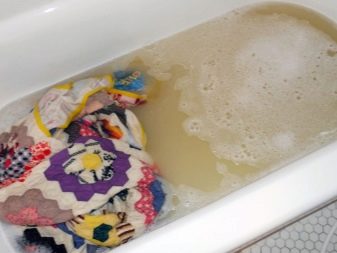
In a washing machine
For the most part, modern machines provide for delicate washing of products made from natural materials. Typically, these modes are called "hand wash", "delicate" or in another way.
You need to use these methods only if the manufacturer of the blanket himself has given the appropriate instructions on the tag. If there is no clear certainty that the product will not deteriorate after washing, you should not risk it.

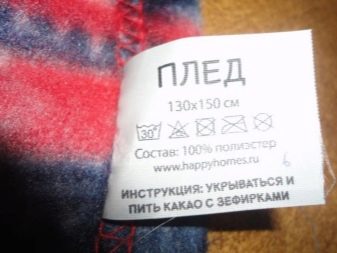
Consider the important conditions when washing a blanket in a washing machine.
- The cover must fit completely into the drum of the unit.
- It is better to roll the product in the shape of a snail (the front side should be inside). This way the material will be easier to put in the drum, and the wash itself will be of better quality.
- The fluffy bedspread can be washed at fairly low temperatures. You should set the minimum number of revolutions during spinning.
- But it is better to give up the automatic spin altogether. Otherwise, the bedspread may deteriorate.
- You need to dry blankets only in the fresh air or in an apartment. It is not recommended to do this in an automatic dryer.
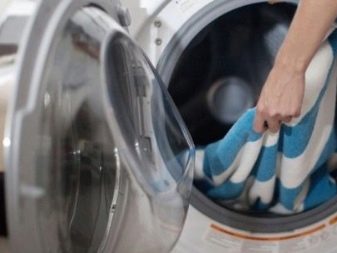

After washing, you need to lightly squeeze the blanket, and let the water drain down. There are several nuances of drying.
- The blanket dries the fastest when placed horizontally. It is better to use special dryers, after laying the canvas on a terry towel.
- After washing, the blanket should be kept in a dark room with good air circulation.... The cover should not be exposed to direct sunlight (bright colors can fade and fade).
- Do not hang products next to heating systems, and also use a hairdryer. This not only will not speed up drying, but may also cause deformation of the product.



The washing program should be chosen depending on the type of material from which the blanket is made and its weight. Different washing parameters will be for synthetic and natural fabrics. Most of the bedspreads have a soft pile. In order to maintain the softness of the material, special care must be taken in the choice of detergents.
It is not recommended to machine wash the wool, but if you do it very carefully, then, most likely, the product will not deteriorate. Woolen fabrics can shrink due to too hot water (the material can also deteriorate due to excessive mechanical movements during hand washing). If the model is washed in a typewriter, then you only need to choose the delicate mode. For such a product, water with a temperature of about 30 degrees is best suited. Woolen items are better washed with special shampoos and gels.
To clean a microfiber blanket, you need hotter water (from 40 to 60 degrees). If you need to wash the plush blanket, then it is better to heat the water to 30 or 40 degrees.



Acrylic models are not so capricious, so the "synthetic" mode is perfect for cleaning them. You cannot wash blankets with ordinary powder (microscopic particles of the agent are poorly washed out of the fabric, and after drying, the blanket may become too hard). Bleach won't work either.
When you need to wash natural fabrics such as cotton, linen, bamboo, then the water in the washing machine should not exceed 40 degrees. This way, shrinkage of the product can be avoided. Models with bright prints are best cleaned with enzyme products. These substances are excellent for all types of dirt and do not affect the brightness of the bedspread. For light-colored blankets, it is better to choose a laundry detergent or use oxygen-based bleach.
Bamboo is a durable and tactilely pleasant fabric that can easily be washed in an automatic machine. The procedure should be carried out in the "delicate" mode, the water should not be hotter than 30 degrees.
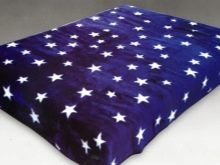


Synthetic fabrics are not so capricious in relation to high temperatures or washing regimes. However, before cleaning such materials, it is better to read the text on the label - it usually details the conditions for caring for the product. The procedure for cleaning the blanket in slightly warm water (from 30 to 40 degrees) will also help to minimize the risks.
Although fabrics made of polyamide or polyester perfectly "cope" with any mechanical stress, it is better to wash them on a medium intensity mode. Liquid products are suitable for these purposes.
To prevent static electricity from accumulating in the product, it is better to add an air conditioner.


In the laundry
This is the best method, since the laundry staff are already familiar with all the nuances of washing bedspreads correctly. However, this method is not available to everyone, and it will not work every time. If there is no shortage of funds, then you can save your time by giving the product for professional cleaning.
The laundry will be able to restore the material, remove even the most stubborn stain, get rid of all types of dirt.
Trusting your things is worth only to a reliable organization, which can be found on the advice of friends, according to reviews on the Internet.

How often should the blanket be washed?
A bedspread with a long pile looks great in the interior and warms up great. The softer such a thing is, the more pleasant it is to fall asleep under a warm blanket. However, soft and delicate fabrics are very difficult to wash and care for. Brush the material with a compact brush as often as possible.
It is best to wash items made from natural fabrics about 2 times a year. If you do this more often, the bedspread will quickly lose its "marketable" appearance.


How to comb a washed product?
After washing, any bamboo blanket sometimes becomes less fluffy. You can solve this problem by shaking the blanket while it is still damp. The same procedure can be carried out on a dry product.
A comb will help to make the bedspread fluffy again.The tool needs to be walked over the pile several times until the canvas becomes soft and delicate again.

Recommendations
To make the bedspread decorate the sleeping place for a long time and look like new, it is necessary to adhere to several rules for caring for the product.
- Laundry should be done in the heat, the best time for this event will be summer or late spring. The blanket will dry out faster, and the procedure itself will be more hygienic. The fact is that the product absorbs a lot of liquid, in which various bacteria feel just fine. In hot weather, bacteria do not develop as quickly.
- You can do without a special tool, taking a regular baby shampoo.
- In some situations, there are strict rules - in this matter it all depends on the material from which the bedspread is made. The easiest one will be to wash synthetic items. Fleece blankets are also quite unpretentious: such fabrics hardly absorb dirt. You can "update" the material if you shake the model well several times - this will help get rid of small debris.
- Quite an unusual way to clean the bedspread: you need to take a small roller with a sticky base. Usually, such a device is used to clean clothes from debris and animal hair. With a roller, you need to walk over the blanket and collect small debris and lint. Of course, this event will not replace high-quality washing, but the product will become noticeably cleaner and even softer. This procedure must be carried out regularly if there are animals in the house.
If you clean the blanket from time to time, then it will not need washing for a long time.









